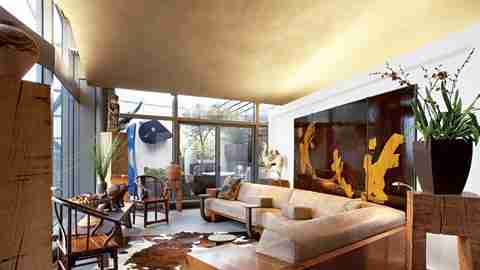View Slideshow

There are many ways to get a bird's-eye view of London. A visit to a soaring skyscraper in the city will do it for most people, while the more intrepid might choose to dangle from a glass cabin on the London Eye. But for those most passionate about London's extraordinary vistas, only a penthouse on the Thames—with all the views, all the time—could fully suffice.
It was not by chance that one couple found this fabulous, fan-shaped perch overlooking London's historic river. "They had been looking for a long time, and they knew they wanted something with exceptional views," explains California-based designer Ron Mann, who was responsible for the project from start to finish. "And when they came here, their immediate reaction was: If you could have only one view of London, it would have to be this. And having realized that, they didn't need to look any further."
"I like to do things against the rules, against the odds. That doesn't always go down easily."
At that point, however, the penthouse was no more than a shell, a cavernous hollow without even the basic utilities installed. "That was another fantastic thing about this apartment," says Mann, who has designed several interiors for the residents over the years. "We had a completely fresh, blank canvas to work on. We thought we might maintain the loftlike space as it was, because I was very keen to keep the light that comes from the floor-to-ceiling windows on both sides of the apartment flowing through unimpeded. But then we hit on the idea of having partial walls topped with clear glass so that we could create a series of rooms without losing the sense of open space and luminosity," he continues. "My clients have an instinctive grasp of everything, from structural engineering down to the last decorative detail, so they were fully involved in all the decisions, both great and small."
Once the overall room sequence had been worked out, with the large lounge, the studio area and the terrace being given pride of place, overlooking the Thames, Mann began to focus on the details. "I like to do things against the rules, against the odds," he says. "That doesn't always go down easily. The floor I designed is a case in point. It's made of cast stone set in a grid of thick Honduras mahogany planks separated by bars of stainless steel, with the curve of the planks reflecting the fan shape of the whole space. One of the local firms we were working with said: It can't be done. Send that man back to California!' But my clients replied: If Ron can design it, we can get it made.' And we did!"
This originality is evident throughout the apartment. While one wall in the entrance is made of powder-coated Cor-Ten steel set with fiber-optic base lights, for instance, others are painted with layers of chalk-white paint to give the impression that they are actually carved out of chalk. Similarly, the dining table consists of two separate tops with interlocking aluminum bases that, when clicked together, form a single, asymmetrical oval table. "My clients love the idea of totally new design concepts, things that have never existed in the world before. Of course, that's a marvelous brief for a designer to have."
The same meticulously innovative attention is paid to everything from the soft furnishings (which include a faux-Arctic wolf bedcovering) to the drawer pulls in the wardrobe. The freestanding pieces of furniture were designed by Mann, who had them made in California before shipping them to London. Particularly notable is the vast sofa in the living area. Made in three separate parts with a frame crafted from solid California bay laurel, the result turned out to be so heavy that it had to be craned up section by section and deposited on the terrace before an army of stalwarts could reassemble it.
Discreetly sited throughout the main rooms, the collection of paintings, sculptures and objects gives a particular resonance to the space. There are a few classic modern works, but the emphasis is on Oriental art. A large four-panel lacquered screen and an ancient salt-glaze jar, both from Japan, subtly set the tone in the living area, but most remarkable is the sheer variety of artworks, which range from a Nepalese bronze Buddha to a Korean paper screen and a Javanese wood carving. Blending effortlessly with their surroundings, they lend an extra dimension of serenity to what is already a secluded haven high above the turmoil of everyday life.

Leave a Reply